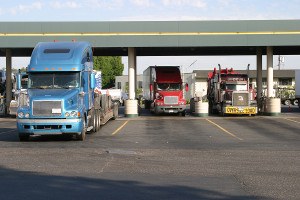Long haul truck telematics have been around for a couple of decades but research suggests that adoption by other commercial vehicle sectors is expected to exceed that industry’s use by 2019, according to ABI Research. By then, more than 50 million commercial vehicles across the globe are expected to have fleet telematics installed.
Utilities, taxis, construction and mining, government and public sectors, emergency services, public transportation and local delivery services will all likely have telematics installed on their vehicles.
 “Many of these verticals are facing similar challenges such as the need to improve the utilization of their vehicle fleets, combat rising fuel prices, trim payroll costs and comply with ‘duty of care’ obligations towards their employees,” said Gareth Owen, principal analyst at ABI Research.
“Many of these verticals are facing similar challenges such as the need to improve the utilization of their vehicle fleets, combat rising fuel prices, trim payroll costs and comply with ‘duty of care’ obligations towards their employees,” said Gareth Owen, principal analyst at ABI Research.
Owen said that, in addition, certain sectors have specific challenges and requirements.
For example, safety, driver behavior and driver fatigue are of paramount concern in the construction and mining sector.
Steve Blackburn, vice president of North America sales and marketing for Navman Wireless, a company that offers fleet managing options to a number of industries, said the company’s telematics products are used in about a quarter of a million vehicles.
“We operate across 14 countries, from the U.S. to Australia to Canada to New Zealand,” Blackburn said.
He said there is really no excuse for companies not to have a complete record of their fleets’ activity and location at any given time. Such data can be a major asset, Blackburn said, providing an extensive audit trail in the event of an incident with possible legal ramifications.
The data can be used for risk mitigation as well as accident reconstruction for cases involving fleets.
In discussing the Tracy Morgan Walmart crash, Blackburn said that paper copy driver logs are only as good as the information provided by the driver.
“Now, the thing with driver logs is, at the moment, it’s legal just to have a paper copy of the driver logs. If you do a paper copy of the driver logs, then clearly you absolutely trust your driver to fill them in correctly. You don’t really get that paper copy until after the event,” said Blackburn.
He explained that many companies are transitioning to electronic logs and that his company offers a product for digital logging of hours.
“The real difference is you can actually see those logs remotely,” said Blackburn. “For example, if a guy does go over his hours and continues driving, you can be alerted that one of your drivers is effectively breaking the rules. And you can do something about it.”
He anticipates the government requiring digital driver logs in the near future.
Navman technology can track the speed and route of a vehicle, verify the speed versus posted speed limits and even monitor driving style.
“We can obviously take into account the limitations on the vehicle, the different speed limits for vans and large, heavy trucks. We can take that into account. We can also have a look at the driving style. Is there excessive acceleration? Is there excessive braking?,” said Blackburn.
Risk assessment profiles can be built based on the tracked information, said the Navman vice president.
“You could identify where your risks are. If you’ve got a guy who’s accelerating a lot and is braking very harshly, most probably tells you that the guy is driving erratically, burning fuel, braking harshly because the chances are he’s too close to vehicles in front,” Blackburn said.
If there is room to improve, the technology allows drivers to attend a driver training school remotely. Once completed, drivers can then be monitored, again remotely.
Insurers offer fleet telematics too – The Hartford offers Fleet Ahead and Travelers offers IntelliDrive. On its website, Travelers outlines a success story about a New York trucking firm that experienced an overturned truck with an injured driver. The injured driver called his employer to explain that he was injured and pinned in the truck and the cell phone connection was lost. The employer had to call 911 operators across the driver’s route to locate him. The company decided to adopt fleet telematics as a result of that incident.
Blackburn cites a large client where a variety of data is being pulled and analyzed to improve driver performance.
“We’re looking at things like reports, the incidents which have happened with this company. Building a profile. Training the drivers. Monitoring performance. Feeding it all in. Identifying who’s at risk using big data. Adaptive intelligence we call it, where we’re pulling lots of information in from different sources,” said Blackburn.
The tracking devices can be adapted to include something akin to a black box, the Navman exec said.
“What this thing does is it has a short term memory,” said Blackburn. “If you get massive deceleration, what it will do is it will trigger an accident buffer. What it does is its constantly storing data on a second by second basis.”
The driver’s company is notified immediately by the program that an accident buffer has been activated and can work to analyze the data much like an accident reconstructionist.
“I think telematics over the last 13 years I’ve been involved in the business has come a long way. It’s no longer really ‘Big Brother’. We live in a world of if there’s blame, there’s a claim and there’s liability. Everybody has to be aware of how they’re operating,” said Blackburn. “With the help of telematics, if it’s positioned and implemented correctly, it can be a real help to people.”
Was this article valuable?
Here are more articles you may enjoy.


 CBS Poised to Lose Bid to Stop Sony Taking ‘Jeopardy’ Rights
CBS Poised to Lose Bid to Stop Sony Taking ‘Jeopardy’ Rights  Group Sues California Department of Insurance Over FAIR Plan Surcharges
Group Sues California Department of Insurance Over FAIR Plan Surcharges  AI Weather Models Promise Super Granular, Specialist Forecasts
AI Weather Models Promise Super Granular, Specialist Forecasts  Europe’s Hottest Year Turbocharged Extreme Weather Across Region
Europe’s Hottest Year Turbocharged Extreme Weather Across Region 